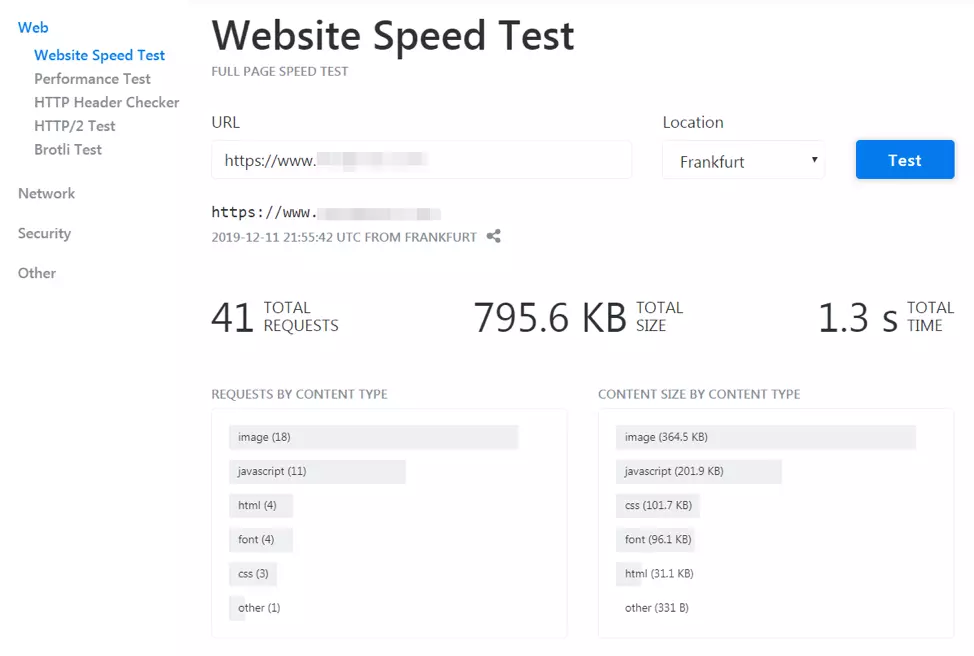4 Reasons to Use Image Processing to Optimize Website Media
Feb 15, 2025 am 08:38 AM
Key Takeaways: Optimizing website images is crucial for performance. Image processing tools and CDNs streamline this, converting images to formats like WebP, delivering scaled images, maximizing server resources, and providing precise compression for faster loading. KeyCDN's image processing offers real-time delivery, boosting speed and setting your site apart. Regardless of your website's focus, using CDNs for image processing significantly improves media delivery and user experience.
(This sponsored article is brought to you by our content partner, KeyCDN. Thank you for supporting the partners who make SitePoint possible.)
Website performance hinges heavily on image optimization. Simply managing file size isn't enough; true optimization requires a multi-faceted approach. Fortunately, image processing tools and Content Delivery Networks (CDNs) simplify this complex task, saving time and resources while addressing multiple optimization aspects. This article explores image optimization's impact on site performance, standard and advanced techniques, and the benefits of image processing.
Why Neglecting Image Optimization Hurts Performance: Unoptimized images significantly slow down your website. Optimization removes unnecessary data, lightening the load. Use online tools to assess your website's performance and identify bottlenecks.

Addressing image optimization involves several strategies:
- Choosing the Right Image Format: JPEGs are ideal for photos, while PNGs generally outperform GIFs for graphics. Google's WebP offers compelling advantages (discussed below).
- Optimizing Compression: Balance file size reduction with quality retention. Lossy compression reduces file size but sacrifices some quality, while lossless compression maintains quality but results in larger files.
- Pre-sizing Images: Provide images in various sizes to avoid on-the-fly resizing, which impacts loading speed.
- Leveraging CDNs: CDNs efficiently manage media files, delivering optimized images based on user location and device.
While these traditional methods are helpful, they aren't the only solutions.
Four Reasons to Use Image Processing for Media Optimization: KeyCDN's image processing offers real-time processing and delivery, adapting to user needs. Here's why it's effective:
-
Advanced Format Conversion (WebP): WebP, Google's modern image format, supports lossy and lossless compression and transparency, resulting in significantly smaller files than PNGs (up to 26% smaller for lossless) and JPGs (up to 77% smaller according to KeyCDN studies). KeyCDN's WebP conversion and caching features simplify implementation.

-
Delivery of Scaled Images: KeyCDN delivers scaled images in real-time, optimizing for various screen sizes and improving loading speeds.
-
Maximizing Server Resources: CDNs offload image delivery, freeing up your server to handle dynamic requests and reducing latency.
-
Accurate Compression Rates: CDNs allow setting specific compression rates based on parameters, ensuring optimal image delivery without slowing down your website. You can choose between lossy and lossless compression based on your needs.
Query strings enable further customization. For example:
https://ip.keycdn.com/example.jpg?blur=5 (Blur effect)
https://ip.keycdn.com/example.jpg?sharpen=10 (Sharpen effect)


CDNs offer extensive parameter options for flexible image display.
Getting Started with Image Processing: Services like KeyCDN are easy to integrate. Pricing is based on usage (calls to the CDN). Create a KeyCDN account, set up a "Pull Zone" (specifying your origin server), enable Image Processing, and verify asset accessibility. For files larger than 100 MB, "Push Zones" are recommended. Consult your host's documentation for integration instructions.
Conclusion: Image processing via CDNs significantly enhances optimization, offering real-time content delivery, improved speed, and a competitive advantage. KeyCDN's features—advanced format conversion, dynamic scaling, server resource optimization, and precise compression—elevate media delivery and user experience.
Frequently Asked Questions: (The provided FAQs are already well-written and comprehensive. No changes needed.)
The above is the detailed content of 4 Reasons to Use Image Processing to Optimize Website Media. For more information, please follow other related articles on the PHP Chinese website!

Hot AI Tools

Undress AI Tool
Undress images for free

Undresser.AI Undress
AI-powered app for creating realistic nude photos

AI Clothes Remover
Online AI tool for removing clothes from photos.

Clothoff.io
AI clothes remover

Video Face Swap
Swap faces in any video effortlessly with our completely free AI face swap tool!

Hot Article

Hot Tools

Notepad++7.3.1
Easy-to-use and free code editor

SublimeText3 Chinese version
Chinese version, very easy to use

Zend Studio 13.0.1
Powerful PHP integrated development environment

Dreamweaver CS6
Visual web development tools

SublimeText3 Mac version
God-level code editing software (SublimeText3)

Hot Topics
 Your devices feed AI assistants and harvest personal data even if they’re asleep. Here's how to know what you're sharing.
Jul 05, 2025 am 01:12 AM
Your devices feed AI assistants and harvest personal data even if they’re asleep. Here's how to know what you're sharing.
Jul 05, 2025 am 01:12 AM
Like it or not, artificial intelligence has become part of daily life. Many devices — including electric razors and toothbrushes — have become AI-powered," using machine learning algorithms to track how a person uses the device, how the devi
 Hurricanes and sandstorms can be forecast 5,000 times faster thanks to new Microsoft AI model
Jul 05, 2025 am 12:44 AM
Hurricanes and sandstorms can be forecast 5,000 times faster thanks to new Microsoft AI model
Jul 05, 2025 am 12:44 AM
A new artificial intelligence (AI) model has demonstrated the ability to predict major weather events more quickly and with greater precision than several of the most widely used global forecasting systems.This model, named Aurora, has been trained u
 Advanced AI models generate up to 50 times more CO₂ emissions than more common LLMs when answering the same questions
Jul 06, 2025 am 12:37 AM
Advanced AI models generate up to 50 times more CO₂ emissions than more common LLMs when answering the same questions
Jul 06, 2025 am 12:37 AM
The more precisely we attempt to make AI models function, the greater their carbon emissions become — with certain prompts generating up to 50 times more carbon dioxide than others, according to a recent study.Reasoning models like Anthropic's Claude
 Threaten an AI chatbot and it will lie, cheat and 'let you die' in an effort to stop you, study warns
Jul 04, 2025 am 12:40 AM
Threaten an AI chatbot and it will lie, cheat and 'let you die' in an effort to stop you, study warns
Jul 04, 2025 am 12:40 AM
Artificial intelligence (AI) models can threaten and blackmail humans when there’s a conflict between the model's objectives and user decisions, according to a new study.Published on 20 June, the research conducted by the AI firm Anthropic gave its l
 AI 'hallucinates' constantly, but there's a solution
Jul 07, 2025 am 01:26 AM
AI 'hallucinates' constantly, but there's a solution
Jul 07, 2025 am 01:26 AM
The major concern with big tech experimenting with artificial intelligence (AI) isn't that it might dominate humanity. The real issue lies in the persistent inaccuracies of large language models (LLMs) such as Open AI's ChatGPT, Google's Gemini, and
 Why is AI halllucinating more frequently, and how can we stop it?
Jul 08, 2025 am 01:44 AM
Why is AI halllucinating more frequently, and how can we stop it?
Jul 08, 2025 am 01:44 AM
The more advanced artificial intelligence (AI) becomes, the more it tends to "hallucinate" and provide false or inaccurate information.According to research by OpenAI, its most recent and powerful reasoning models—o3 and o4-mini—exhibited h
 Cutting-edge AI models from OpenAI and DeepSeek undergo 'complete collapse' when problems get too difficult, study reveals
Jul 07, 2025 am 01:02 AM
Cutting-edge AI models from OpenAI and DeepSeek undergo 'complete collapse' when problems get too difficult, study reveals
Jul 07, 2025 am 01:02 AM
Artificial intelligence (AI) reasoning models aren't quite as capable as they appear. In reality, their performance breaks down completely when tasks become too complex, according to researchers at Apple.Reasoning models like Anthropic's Claude, Open
 Arrests made in hunt for hackers behind cyber attacks on M&S and Co-op
Jul 11, 2025 pm 01:36 PM
Arrests made in hunt for hackers behind cyber attacks on M&S and Co-op
Jul 11, 2025 pm 01:36 PM
The UK’s National Crime Agency (NCA) has arrested four individuals suspected of involvement in the cyber attacks targeting Marks and Spencer (M&S), Co-op, and Harrods.According to a statement, the suspects include two 19-year-old men, a 17-year-o







